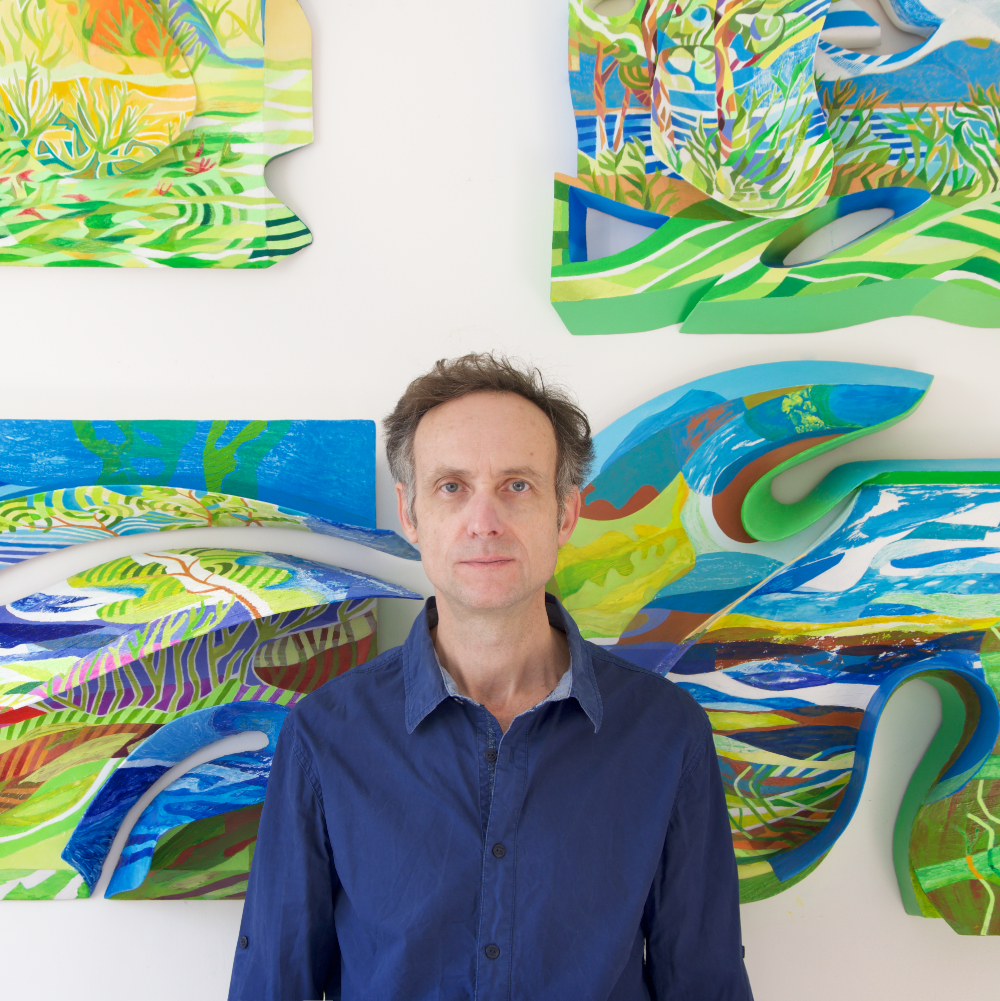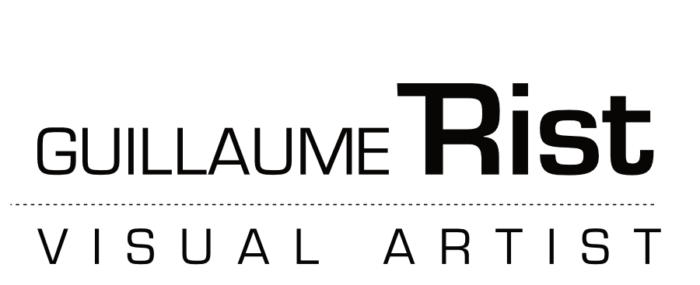À PROPOS
ABOUT

Modeler, façonner, creuser, courber, tordre son sujet, le construire, prendre des chemins de traverse et rentrer dans les dédales intérieurs.
SUIVRE LA LIGNE
Guillaume RIST est artiste plasticien français. Il développe une pratique située à l’intersection du design, de la peinture, et de la sculpture murale. Son parcours initial en design industriel — amorcé à l’École Maryse Éloy – Beaubourg, puis approfondi à l’ESDI (École Supérieure de Design Industriel) — influence sa recherche plastique. Il a exercé pendant plusieurs années comme designer graphique et directeur artistique au sein d’agences d’édition, avant d’orienter progressivement sa production vers une démarche autonome en arts plastiques, engagée professionnellement depuis 2020.
Sa pratique repose sur un travail de transformation formelle, où les objets ou figures référencés sont soumis à un processus de modélisation plastique : remodelage, torsion, courbure, dislocation, recomposition. Cette recherche s’inscrit dans une dynamique de métamorphose, consistant à faire évoluer la forme sans en altérer la charge sémantique.
L’artiste explore ainsi un entre-deux visuel : ni figuration stricte, ni abstraction totale, mais un état transitoire où le référent initial subsiste en filigrane.
Influencé par les courants du Pop Art et de l’Op Art, tant dans le traitement graphique que dans l’usage d’une chromie saturée et contrastée, il construit une peinture où les effets de surface (lignes, motifs, aplats, rythmes visuels) produisent des tensions internes qui sollicitent l’œil du spectateur. Les compositions, souvent narratives, sont habitées par un silence, des mises en scène énigmatiques, où coexistent éléments réels et oniriques.
MODELING, une recherche sur la plasticité
Son travail s’inscrit dans une démarche de déconstruction/reconstruction formelle. Le processus commence par un travail de dessin préparatoire visant à définir les contours, les zones de tension et les lignes de force de la forme d’origine. À partir de là, l’artiste engage un processus de distorsion, de fragmentation ou de reconfiguration volumique.
Graphiquement, cette transformation se traduit par l’emploi de lignes courbes, d’alternances de motifs linéaires (rayures, vagues, arêtes) et de contrastes chromatiques vifs, dans une logique proche d’effet cinétique . L’agencement de ces éléments produit une dynamique interne, une chorégraphie dans le tableau. La couleur, pensée comme vecteur de mouvement, renforce cette sensation de basculement entre figuration et abstraction.
On retrouve son travail dans 4 thématiques principales :
• Les Reliefs Naturels, série de sculptures murales en bois peint, explorant la relation entre géométrie organique et matière.
• Humans, étude des figures humaines, souvent fragmentées ou recomposées.
• Natures vivantes, revisiter le thème de la nature morte, traitée sous un angle symbolique et narratif.
• Les Classiques, réinterprétations d’œuvres iconiques de l’histoire de l’art, selon une grille plastique propre à l’artiste (déconstruction graphique, recoloration, distorsion).
TECHNIQUES
Son travail porte à la fois sur la peinture en deux dimensions sur toile, et sur la peinture en volume au travers ses sculptures murales. « Les Reliefs naturels» regroupe une série de sculptures murales associant peinture et sculpture avec une attention sur le travail de la matière, jouant le rôle de liant entre ses deux médiums.
Il utilise l’acrylique sur toile, ainsi que le collage, et le bois pour ses sculptures. Un autre support vient compléter son travail : la peinture numérique. Avec la technique des estampes numériques et les dessins réalisés sur palette graphique, il expérimente un rendu contemporain qui joue en particulier sur les superpositions de traits et d’aplat couleurs.
C’est d’abord une recherche formelle qui commence par le dessin : définir les contours, les pleins et les vides et trouver des lignes de force, choisir une palette de couleurs. Puis un report du dessin sur la toile et le début de la peinture.
Pour les sculptures : avant la peinture, c’est une phase de découpe et assemblage en bois et papier avec en trame de fond un dessin préparatoire.
Conclusion
Sa pratique s’inscrit dans une réflexion élargie sur la forme en mutation, où le dessin sert de matrice à une exploration multi-supports : toile, volume, impression numérique. À travers cette approche technique rigoureuse, nourrie d’un héritage graphique, il propose un langage plastique personnel, oscillant entre figuration transformée et abstraction contrôlée.
FOLLOW THE LINE
Guillaume RIST is a French visual artist. He develops a practice located at the intersection of design, painting, and mural sculpture. Her initial career in industrial design, initiated at the Maryse Éloy – Beaubourg School, then deepened at the ESDI (Ecole Supérieure de Design Industriel), influences her plastic research. He worked for several years as a graphic designer and artistic director within publishing agencies, before gradually orienting his production towards an autonomous approach in visual arts, professionally committed since 2020.
His practice is based on a work of formal transformation, where the referenced objects or figures are subjected to a plastic modeling process: remodeling, torsion, curvature, dislocation, recomposition. This research is part of a dynamic of metamorphosis, consisting in making the form evolve without altering its semantic charge.
The artist thus explores a visual in-between: neither strict figuration nor total abstraction, but a transitional state where the initial referent remains in the background.
Influenced by the currents of Pop Art and Op Art, both in the graphic treatment and in the use of saturated and contrasted chromia, he constructs a painting where surface effects (lines, patterns, flat, visual rhythms) produce internal tensions that call upon the viewer’s eye. The compositions, often narrative, are inhabited by a silence, enigmatic staging, where real and dreamlike elements coexist.
MODELING, a research on plasticity
His work is part of a process of deconstruction/formal reconstruction. The process begins with preparatory drawing work aimed at defining the contours, tension areas and lines of force of the original shape. From there, the artist engages in a process of distortion, fragmentation or volumetric reconfiguration.
Graphically, this transformation results in the use of curved lines, alternating linear patterns (stripes, waves, edges) and vivid chromatic contrasts, in a logic close to kinetic effect. The arrangement of these elements produces an internal dynamic, a choreography in the painting. Color, thought as a vector of movement, reinforces this feeling of tipping between figuration and abstraction.
We find his work in 4 main themes:
• The Natural Reliefs, a series of wall sculptures in painted wood, exploring the relationship between organic geometry and matter.
• Humans, study of human figures, often fragmented or recomposed.
• Living natures, revisiting the theme of still life, treated from a symbolic and narrative angle.
• The Classics, reinterpretations of iconic works from art history, according to a plastic grid specific to the artist (graphic deconstruction, recoloration, distortion).
TECHNIQUES
His work focuses both on two-dimensional painting on canvas, and on volume painting through his wall sculptures. « Les Reliefs naturels » brings together a series of wall sculptures combining painting and sculpture with an attention on the work of matter, playing the role of binder between its two mediums.
He uses acrylic on canvas, as well as collage, and wood for his sculptures. Another medium completes his work: digital painting. With the technique of digital prints and drawings made on a graphic palette, he experiments with a contemporary rendering that plays in particular on the superposition of lines and flat colors.
It is first of all a formal research that begins with the drawing: define the contours, the full and the empty and find lines of force, choose a palette of colors. Then a report of the drawing on the canvas and the beginning of the painting.
For the sculptures: before painting, it is a phase of cutting and assembling in wood and paper with a preparatory drawing as background.
Conclusion
His practice is part of a broader reflection on the changing form, where drawing serves as a matrix for a multi-media exploration: canvas, volume, digital printing. Through this rigorous technical approach, nourished by a graphic heritage, he proposes a personal plastic language, oscillating between transformed figuration and controlled abstraction.

